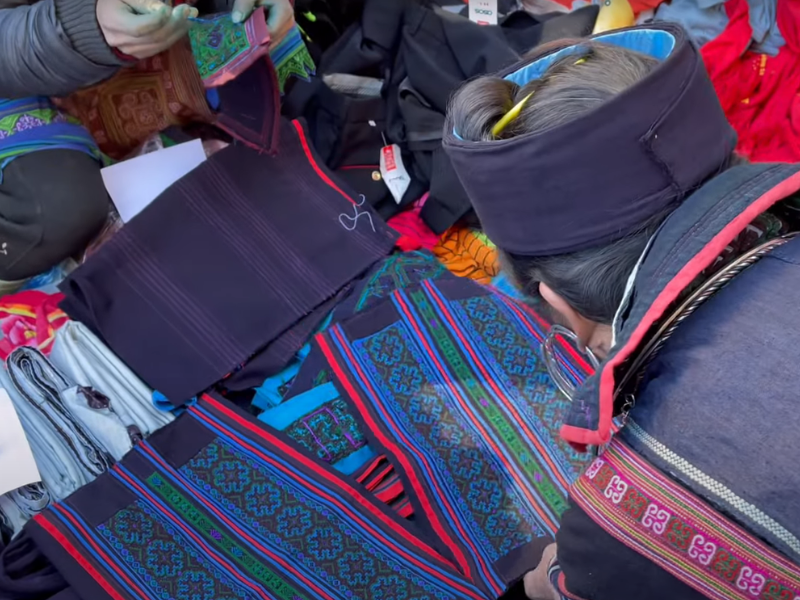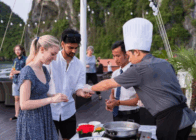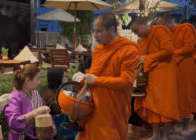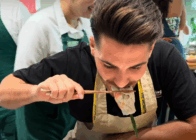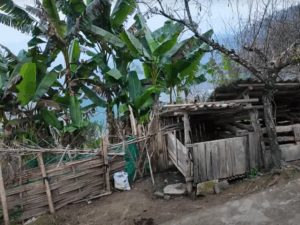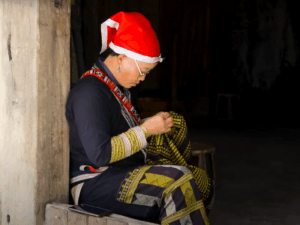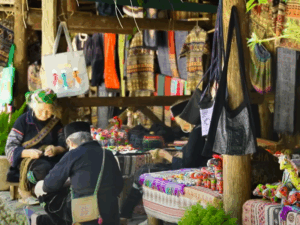Sapa, located in the mountainous region of Northern Vietnam, is known for its traditional arts and crafts that have been passed down through generations. The local artisans skillfully create handmade items such as textiles, pottery, and jewelry, using natural materials that reflect their way of life. By purchasing local handicrafts, you can not only contribute to the preservation of these traditional skills but also support the local community. In this blog, we’ll explore the beauty of Sapa’s handicrafts and how you can support the local community by purchasing them.
The Tradition of Handicrafts
Handicrafts in Sapa are not merely souvenirs; they are a vibrant expression of the region’s ethnic minority groups, including the H’mong, Dao, Tay, and Giay people. These communities have been crafting intricate items for generations, each piece telling a story of cultural heritage and familial pride. From the colorful brocade weaving of the H’mong to the delicate embroidery of the Dao, these crafts are deeply rooted in the history and everyday life of Sapa’s residents. They serve as a bridge between past and present, preserving traditions while adapting to contemporary tastes.
The Craftsmanship
The artistry involved in Sapa’s handicrafts is nothing short of awe-inspiring. Each craft requires a unique set of skills and techniques, honed over years of practice and passed down through generations.
Brocade Weaving
The H’mong women are particularly known for their brocade weaving, a craft that involves creating intricate patterns on fabric using a loom. The vibrant colors and elaborate designs reflect both the artisan’s creativity and the community’s stories and folklore.
Silver Carving
Silver carving is another prominent craft, with Mr. Cuong being a notable figure in this field. Combining traditional techniques with modern designs, his work has garnered attention both locally and internationally. His workshop not only produces stunning jewelry and ornaments but also serves as a training ground for aspiring artisans.
Woodwork
Woodwork in Sapa is equally impressive. Artisans like Mr. Linh carve exquisite pieces from sustainable wood sources, infusing each item with a sense of authenticity and environmental respect. His reflections on the challenges and rewards of sustainable woodworking highlight the importance of preserving natural resources for future generations.
Embroidery
Embroidery in Sapa is a beautiful blend of tradition and artistry. The Dao women, renowned for their impeccable needlework, create stunning patterns that tell tales of their heritage. Each piece of fabric adorned with intricate stitches becomes a canvas that showcases their creativity and meticulous attention to detail. The vibrant threads used in their embroidery work bring to life scenes from nature, folklore, and daily life, making each item not just a piece of cloth but a story told through threads.
Indogo Dyeing
The ancient art of indigo dyeing is another fascinating craft practiced by the H’mong people. The process begins with harvesting indigo plants, which are then fermented to produce a rich, blue dye. Fabric dipped into this dye undergoes a magical transformation, emerging in shades of blue that range from deep navy to pale azure. The H’mong artisans often combine indigo dyeing with batik techniques, using wax to create intricate patterns on the fabric, resulting in pieces that are as captivating as they are colorful.
The Marketplace
Sapa’s local marketplace is a vibrant hub where these exquisite handicrafts come together. Strolling through the bustling stalls, one is greeted with a kaleidoscope of colors, textures, and patterns. The air is filled with the sounds of lively bargaining, the hum of conversations, and the occasional laughter of children playing nearby. This marketplace is not just a place of commerce but a cultural melting pot where traditions are celebrated, stories are exchanged, and the community’s rich heritage is proudly displayed for all to see.
Traditional H’mong Music and Dance
But the vibrancy of the H’mong culture isn’t limited to their crafts; it spills over into their music and dance as well. Imagine the lively sounds of traditional H’mong instruments filling the air, the bamboo flutes and lusheng pipes blending in a symphony that is both rhythmic and melodious. This music isn’t just for listening—it’s an invitation to dance. The H’mong people perform energetic dances in their colorful attire, each movement telling stories of their history, nature, and daily lives. Their dances often involve intricate footwork and hand gestures, symbolizing everything from planting crops to celebrating the harvest.
Culinary Delights
No journey into H’mong culture would be complete without savoring their cuisine. Traditional H’mong dishes are a delightful blend of flavors, textures, and colors, often made from ingredients sourced directly from their lush, mountainous surroundings. Think of a hearty bowl of “Thit Kho,” a savory pork stew simmered with caramelized sugar and coconut juice, or “Xoi,” sticky rice tinted with natural herbs that infuse the grains with a rainbow of hues and rich flavors. Their cooking techniques, passed down through generations, ensure that each meal is not just food for the body, but nourishment for the soul. Enjoying a H’mong meal is an experience that leaves you with a deeper appreciation for their relationship with nature and their culinary ingenuity.
Reconnect with tradition, feel the rhythm of their dance, and taste the essence of their homeland; with every thread, note, and flavor, the H’mong people of Sapa invite you into a world where culture is lived and celebrated every single day.
Sourcing Sustainable Materials
Sustainability is a cornerstone of Sapa’s handicraft industry. Local artisans prioritize using materials that are both environmentally friendly and culturally significant. For example, brocade weavers often use natural dyes derived from plants, while woodworkers source timber from managed forests. This commitment to sustainability ensures that the crafts not only honor tradition but also contribute to the well-being of the environment.
The Economic and Social Impact
Handicrafts play a crucial role in Sapa’s economy and social fabric. They provide a stable income for many families, empowering women and supporting community development. Mai, a H’mong woman, is a shining example of this impact. Through her initiative to revitalize brocade weaving, she has provided employment and revitalized a cultural tradition that might otherwise have been lost.
Moreover, the handicraft industry fosters a sense of community and shared purpose. Artisans collaborate, share knowledge, and support each other, creating a network of mutual aid and cultural preservation. This sense of community extends to visitors, who are often invited to learn about the crafts and even try their hand at creating their own pieces.
Engaging the Next Generation
Inspiring the next generation to embrace and continue Sapa’s rich handicraft traditions is vital for preserving this cultural heritage. Numerous initiatives focus on educating young people about these time-honored skills. Local schools and community centers offer workshops where children can learn techniques such as brocade weaving, wood carving, and silver crafting. These interactive sessions are not just about skill acquisition; they also teach the value of cultural heritage, environmental stewardship, and community collaboration.
Mai’s workshop, for instance, has become a vibrant hub where young and old come together to share stories and techniques, fostering an environment of creativity and learning. Youths are encouraged to experiment and infuse traditional designs with modern twists, ensuring the crafts remain relevant and appealing. Through this blend of instruction and innovation, a new generation of artisans is emerging, poised to carry Sapa’s handicraft legacy into the future with pride and ingenuity.
Where to Find Sapa Handicrafts
Visitors to Sapa can explore a variety of venues to discover and purchase authentic handicrafts. Markets such as Sapa Market and Bac Ha Market are bustling hubs where artisans sell their creations. Additionally, many villages offer workshops and demonstrations, providing a hands-on experience of the crafting process. Places like Cat Cat Village and Ta Phin Village are particularly popular for their immersive cultural experiences.
Personal Stories
The personal stories of Sapa’s artisans add a deeply human dimension to the region’s handicrafts:
Mai’s Revitalization of Brocade Weaving: Mai has breathed new life into her community’s brocade weaving tradition. Her efforts have not only preserved this art form but also provided a stable income for many women in her village, fostering economic independence and cultural pride.
Mr. Cuong’s Silver Carving Workshop: Mr. Cuong, a master silver carver, has successfully adapted traditional techniques to create contemporary designs. His workshop has become a center for learning, attracting young artisans eager to master the craft. The economic growth and international recognition he has achieved underscore the potential of combining tradition with innovation.
Mr. Linh’s Sustainable Woodworking: Mr. Linh’s dedication to using sustainable wood sources has been both challenging and rewarding. His reflections on the craft highlight the importance of environmental stewardship and the profound connection between artisan and material.
Conclusion
The handicrafts of Sapa are more than just beautiful objects; they are a testament to the region’s rich cultural heritage, artistic ingenuity, and commitment to sustainability. Each piece crafted in this picturesque town embodies the spirit of its people, the traditions they cherish, and the future they envision. By supporting these artisans, visitors contribute to the preservation of a unique cultural legacy and the promotion of sustainable tourism.
Ultimately, it’s clear that by supporting the local artisans of Sapa, we can make a significant and positive impact on their livelihoods. The unique designs and intricate detailing of the handicrafts are astonishingly beautiful, making them an ideal gift for any occasion. Additionally, purchasing these handicrafts help to increase their income and sustain the rich culture of the region. It is only through collaboration between travelers and producers that this type of craftsmanship can be preserved and celebrated in today’s world. So take a chance and explore not just the land of Sapa but also its people through buying local handicrafts – it’s much more than simply shopping, it’s forming connections with your fellow human beings from around the globe! Let us join forces to assist artisans in achieving sustainable economic success through their heartwarming creations – handiwork such as embroidery, fermented wine, blankets, jewelry – and let’s acknowledge their invaluable contributions to our lives! Buy Handicrafts of Sapa today!
We invite you to immerse yourself in the enchanting world of Sapa’s handicrafts. Whether you visit in person or explore from afar, your support helps keep these timeless traditions alive. Share this journey with others and encourage them to discover the magic of Sapa’s artisanal heritage.
Visit Sapa, engage with the artisans, and be part of a story that intertwines creativity, culture, and sustainability. Let’s celebrate the handicrafts of Sapa and the incredible people behind them.
- The Best Exotic Vietnam – 16 Days / 15 Nights (75 views)
- Uncover Cambodia’s Hidden Charms 6 Days / 5 Nights (69 views)
- Top Vietnam Tour Operators – The Ultimate Guide to the Best Tour Companies for Vietnam (37 views)
- Seamless Cruise: Halong Bay to Da Nang – Fostering smooth travel experience from Halong Bay to Da Nang. (36 views)
- Vietnam Culinary Tour: Your Definitive Guide to a Food Lover’s Journey (34 views)

